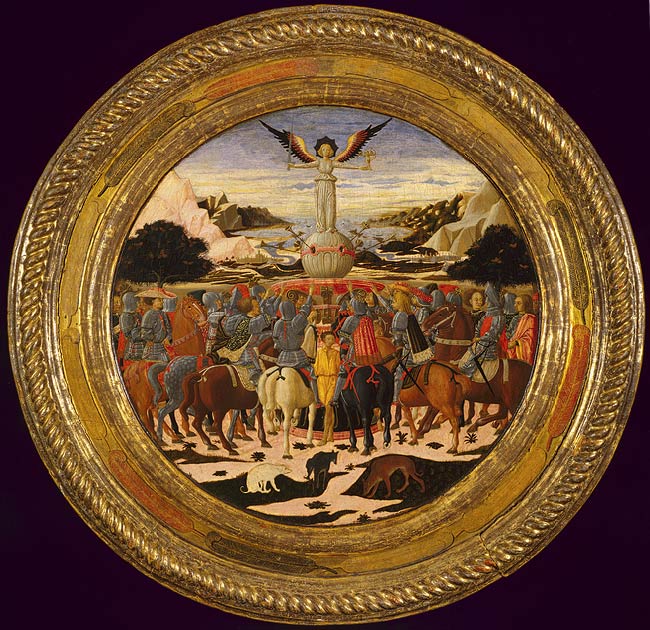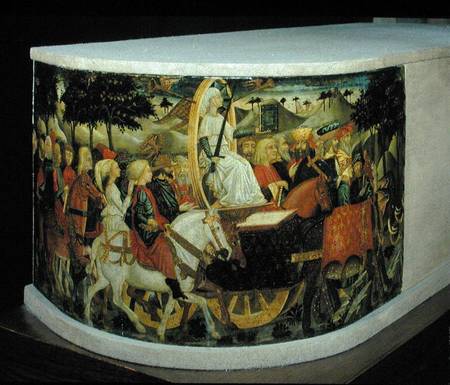Huck
This Italian language source:
Lorenzo il Magnifico e il suo tempo
By Ingeborg Walter
http://books.google.com/books?id=PO...olita&sig=buuxd0oqgexVAtF0gSxOwvLcdmE#PPA8,M1
although limited in its online-representation, includes some information about the birth of Lorenzo de Medici, that is also about the motif "Fame", chosen by Pietro di Medici for the birth-tondo for Lorenzo de Medici.
p. 8 and the following pages
First the date of day of birth (in 1449) is remarkable.
1.1. ... this was a day, when gambling was allowed (not necessarily in Florence), at least often used for games.
6.1. ... the day, when Lorenzo was baptised. The event was combined with great pomp, which ... as it seems ... annually happened in Florence, cause it seems they had a favor for the 3 Magi (already then). At least there existed already a confraternity for this feast and Cosimo was active in directive functions in it since 1436.
It seems, that the show was combined with rappresentatione, telling the story of the Magi.
Considering, what later happened: The Medici paid for the decoration of the famous Medici Capella, where Benito Gozzoli painted his masterwork, the triumphal march of the 3 Magi, it's obvious, they couldn't have found a better day for this act.
Lorenzo ... the name. The name was given reminding the dead brother of Cosimo, also named Lorenzo, who, very interesting, died 23rd of September 1440, that is precisely short before all this Trionfi engagement in 1441 started (inclusive the specific engagement of Piero de Medici with Petrarca-production and literary competition in Florence).
I think, it was mainly this Lorenzo (and less Cosimo), who made it possible, that the council moved from Ferrara to Florence).
Lorenzo .. the name is a male form of "Laura" and Laura was the name of the admired female idol of Petrarca.
So ... the engagement of Piero for Petrarca in matters of the Trionfi edition and the poetical competition in 1441 should be connected to the death of his uncle Lorenzo, and the birth of his oldest son, baptising him on the name of this same uncle, also.
The choice for the motif "Fame" for the birth-Tondo is only "connected action" then.

Some info to Lorenzo:
Wikipedia:
http://www.palazzo-medici.it/mediateca/schede.php?id_scheda=53&sezione=0
It seems, that the younger brother Lorenzo was more loved than Cosimo in his lifetime (very active, loved hunting and his dogs). It seems, that his contacts to poets were more vivid than those of Cosimo.
Especially the closer contact of Lorenzo to the poets might have motivated Piero to fill the vacuum after his death and lead to the constructive Trionfi ideas.
Lorenzo il Magnifico e il suo tempo
By Ingeborg Walter
http://books.google.com/books?id=PO...olita&sig=buuxd0oqgexVAtF0gSxOwvLcdmE#PPA8,M1
although limited in its online-representation, includes some information about the birth of Lorenzo de Medici, that is also about the motif "Fame", chosen by Pietro di Medici for the birth-tondo for Lorenzo de Medici.
p. 8 and the following pages
First the date of day of birth (in 1449) is remarkable.
1.1. ... this was a day, when gambling was allowed (not necessarily in Florence), at least often used for games.
6.1. ... the day, when Lorenzo was baptised. The event was combined with great pomp, which ... as it seems ... annually happened in Florence, cause it seems they had a favor for the 3 Magi (already then). At least there existed already a confraternity for this feast and Cosimo was active in directive functions in it since 1436.
It seems, that the show was combined with rappresentatione, telling the story of the Magi.
Considering, what later happened: The Medici paid for the decoration of the famous Medici Capella, where Benito Gozzoli painted his masterwork, the triumphal march of the 3 Magi, it's obvious, they couldn't have found a better day for this act.
Lorenzo ... the name. The name was given reminding the dead brother of Cosimo, also named Lorenzo, who, very interesting, died 23rd of September 1440, that is precisely short before all this Trionfi engagement in 1441 started (inclusive the specific engagement of Piero de Medici with Petrarca-production and literary competition in Florence).
I think, it was mainly this Lorenzo (and less Cosimo), who made it possible, that the council moved from Ferrara to Florence).
Lorenzo .. the name is a male form of "Laura" and Laura was the name of the admired female idol of Petrarca.
So ... the engagement of Piero for Petrarca in matters of the Trionfi edition and the poetical competition in 1441 should be connected to the death of his uncle Lorenzo, and the birth of his oldest son, baptising him on the name of this same uncle, also.
The choice for the motif "Fame" for the birth-Tondo is only "connected action" then.

Some info to Lorenzo:
Wikipedia:
Lorenzo di Giovanni de' Medici (c. 1395 – September 23, 1440) was an Italian banker of the House of Medici of Florence, the younger brother of Cosimo de' Medici the Elder and the founder of the so-called dei Popolani line of the family.
Lorenzo was the son of Giovanni di Bicci de' Medici and Piccarda Bueri, and was educated by Carlo Marsuppini. In 1416 he married Ginevra Cavalcanti, from whom he had two sons: Francesco, who was childless, and Pierfrancesco, who originated the Popolani line.
Lorenzo followed his brother Cosimo in his moves at Ferrara, Verona and Vicenza. In 1433 he tried to muster an army to free Cosimo when the latter was arrested under the charge of tyranny. Later he joined him at Venice and returned with him in Florence triumphantly after Cosimo's rehabilitation.
Though dedicating himself much to banking activity, Lorenzo held several charges in the Florentine Republic, and was ambassador to Pope Eugene IV and the Republic of Venice. In 1435 he moved to Rome to oversee the affairs of the Medici Bank at the Papal court.
He died in 1440 in the Villa of Careggi and was buried in the Basilica of San Lorenzo.
http://www.palazzo-medici.it/mediateca/schede.php?id_scheda=53&sezione=0
Figlio di Giovanni di Bicci e Piccarda de’ Bueri, Lorenzo era fratello minore di Cosimo il Vecchio. Fu suo precettore Carlo Marsuppini.
Molto legato al fratello Cosimo, con questi nel 1430 andò a Ferrara, Verona e poi Venezia fuggendo da Firenze dove dilagava la peste. Nel 1433 era alla residenza del Trebbio in Mugello, quando Cosimo fu arrestato. Lorenzo allora tentò di radunare alcuni armati per rientrare con la forza a Firenze, ma fu dissuaso. Così prese i figli di Cosimo, lo raggiunse in esilio a Venezia.
In generale si tenne al di fuori della vita politica impegnandosi soprattutto negli affari del banco di famiglia e rimanendo nell’ombra rispetto al fratello maggiore. Nel 1431 fu eletto fra i Dieci di Balia. Fu più volte ambasciatore in legazioni fiorentine: nel 1429 presso i veneziani; nel 1431 a Roma presso papa Eugenio IV in occasione della sua elezione pontificale; nel 1438 a Ferrara, al posto di Cosimo che era stato nel frattempo eletto gonfaloniere, per convincere lo stesso Eugenio IV a trasferire il concilio fra la Chiesa d’Occidente e la Chiesa d’Oriente a Firenze.
Nel 1435 si trasferì a Roma come depositario delle entrate della Camera Apostolica.
Sposò Ginevra di Giovanni di Amerigo Cavalcanti.
Secondo quanto riportano le fonti e i suoi panegiristi (Poggio Bracciolini, Pacini, Vespasiano da Bisticci) fu un uomo di buona salute, molto attivo, amante della campagna, della caccia e dei cani. In una lettera del 1440 scrive al nipote Giovanni per ringraziarlo dei cani che gli aveva mandato e gli comunica che glieli avrebbe restituiti per averne degli altri.
Nel 1440 morì alla villa di Careggi. Fu sepolto in San Lorenzo. I figli Pierfrancesco e Francesco passavano quindi sotto la tutela dello zio Cosimo il Vecchio.
It seems, that the younger brother Lorenzo was more loved than Cosimo in his lifetime (very active, loved hunting and his dogs). It seems, that his contacts to poets were more vivid than those of Cosimo.
Especially the closer contact of Lorenzo to the poets might have motivated Piero to fill the vacuum after his death and lead to the constructive Trionfi ideas.



